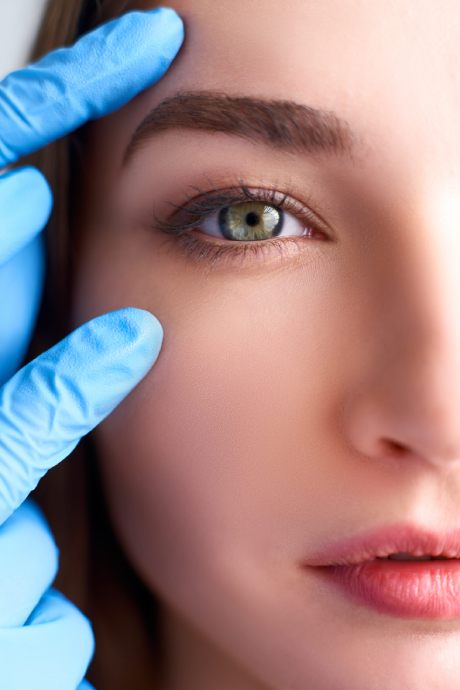BLEPHAROPLASTY
Rejuvenate your look
It is a minimally invasive surgery performed to treat excess skin of the upper eyelids and fat bags of the lower eyelids, which often give the appearance of tired and aged eyes.
Preoperative
The first time you go for a consultation, the surgeon will evaluate your general health, vision, and tear production. During this review, the specialist will determine if it is more convenient to operate the four eyelids or only the upper or lower ones. In addition, he/she will answer any questions you may have and will give you a series of instructions to prepare you for the surgery.
Intervention
The surgery time varies between 45 minutes and 90 minutes. In surgeries in which all four eyelids are operated on, the upper eyelids are operated on first, an incision is made, and the excess skin is removed. In cases of excessive skin flaccidity, the incision areas are in the upper eyelid lines and just below the eyelashes in the lower eyelid and are closed with very fine sutures. The surgeon will determine whether the incision will be transconjunctival or just below the eyelashes on a case-by-case basis.
The specific recommendations at discharge are relative rest, sleep with the head elevated, and apply local ice.
Postoperative
Initially there may be some swelling in the operated area and some superficial bruising, but the pain is controlled with a course of analgesic and anti-inflammatory treatment.
The stitches are removed in consultation after 5-7 days. In general, patients can return to work after 7 days.

What is blepharoplasty and what does it consist of?
Blepharoplasty (or blepharochalasis) is the operation to remove excess skin from the eyelids along with the hernias of fat that form the eyelid bags.
Blepharoplasty can be performed alone or in conjunction with other facial rejuvenation surgeries. In particular cases, this intervention may have a functional and not only aesthetic value.
What are the indications for blepharoplasty?
Blepharoplasty is recommended in case of:
- Eye bags: due to accumulation of periorbital adipose tissue
- Droppy eyes: drooping of the eyelids, which gives a sad and tired look
- Excess skin: excess skin over the eyes that covers the eyelid crease
- Dark circles under the eyes and depression of the periorbital skin
- Crow's feet and skin laxity
- Eyelid swelling that often causes minor discomfort, such as redness, tearing or narrowing of the field of vision
How is blepharoplasty performed?
Blepharoplasty can be performed on the upper eyelid, lower eyelid, or both (full blepharoplasty). The incisions and resulting scars are located in the upper eyelid (at the level of the eyelid crease) and can sometimes protrude a few millimeters from the orbital arch. On the lower eyelid, on the other hand, the scars are located a few millimeters from the lower ciliary margin.
The surgeon separates the cutaneous tissue from the adipose and muscular tissue, eliminating the excess parts, as in the case of bags under the eyes. The sutures are placed so that the scars are minimal but will conform to the natural creases of the upper eyelids, and for lower blepharoplasty will be just below the rima of the eyelid.
Blepharoplasty is performed under local anesthesia, usually combined with intravenous sedation, so that you are not fully alert during the procedure.
The procedure lasts between 20 minutes and 2 hours, depending on the complexity and whether it is an upper, lower, or complete blepharoplasty (upper-lower blepharoplasty).
Postoperative: What are the rules of conduct for proper healing?
- proper eye hygiene
- use of cold compresses or ice
- use of eye drops
- keep the head elevated and sleep with two pillows for at least one week
- do not strain your eyes (television, reading, etc.)
- do not drink alcohol
- do not wear contact lenses until completely healed
- preferably go out wearing dark glasses
- do not expose yourself to the sun
INTERVENTION TIME
1-2h
BED
At least 3 days
RECOVERY
1 month without sports
ANESTHESIA
Local o Full
EFFECT
1 month
RESULTS
1 month
The information provided on the website does not replace but rather complements the relationship between the health professional and their patient or visitor and in case of doubt you should consult your reference health professional.
 English
English  Español
Español 